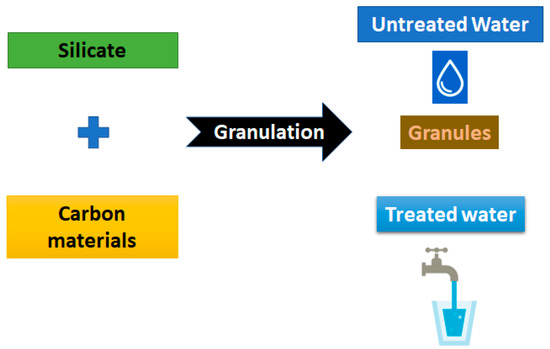The use of binders in the preparation of materials for a wide range of applications is a well-known practice. In this work, we explore the use of silicates as binders to aggregate carbon materials for applications as adsorbents, Figure 1. A set of binders of the family of silicates, among them sodium silicate and some commercial silicates (LUDOX® AS-40, Ludox® AM and Ludox® TMA), were used in the agglomeration of a commercial adsorbent (Activated Carbon-AC) by direct spray dispersion and a rotary technique. The best agglomeration conditions obtained with AC were replicated with a non-commercial carbon adsorbent of a lignocellulosic nature prepared in our laboratory. Selected samples were also submitted to thermal treatment (in a non-controlled atmosphere and inert atmosphere), and physical activation with carbon dioxide (CO2) aimed to increase grain stability and improve the adsorptive properties of the samples, namely their surface chemistry and porosity.

Figure 1.
Process flow diagram of the preparation and use of adsorbent materials.
The samples with a higher mechanical stability and better structural and chemical properties were used in the adsorption of toxic substances in liquid phase, namely arsenic. In these aqueous-phase adsorption experiments, parameters such as agitation, temperature, pH, concentration of the adsorptive, and kinetic aspects were evaluated. A first cost analysis of the process will be also presented.
This work shows how silicate solutions, with an initial concentration ranging from 10 to ~30%, could be employed as binders to granulate carbon materials adsorbents for use on batch and fixed-bed column adsorption systems. Furthermore, this work follows a circular economy approach based on the use of adsorbent materials of natural and renewable origin, particularly lignocellulosic waste and environmentally friendly binders, such as silicates, aiming to prepare an added-value material with potential applications in the treatment of drinking water and wastewater.
Author Contributions
Conceptualization, P.M.; methodology, P.M., I.C. and J.C.; validation, P.M., I.C. and J.C.; investigation, C.C., P.M., I.C. and J.C.; writing—original draft preparation, C.C., P.M., I.C. and J.C.; writing—review and editing, P.M., I.C. and J.C.; supervision, P.M. and L.R.; project administration, P.M.; funding acquisition, P.M. All authors have read and agreed to the published version of the manuscript.
Funding
C.C., P.M., I.C. and J.C. are grateful for the partial funding of this work by the LIFE BIOAs project (LIFE19 ENV/IT/000512) and to W. R. Grace & Co.-Conn. (Columbia, MD, USA) for supplying some of the silicates.
Institutional Review Board Statement
Not applicable.
Informed Consent Statement
Not applicable.
Data Availability Statement
Not applicable.
Conflicts of Interest
The authors declare no conflict of interest.
Publisher’s Note: MDPI stays neutral with regard to jurisdictional claims in published maps and institutional affiliations. |
© 2022 by the authors. Licensee MDPI, Basel, Switzerland. This article is an open access article distributed under the terms and conditions of the Creative Commons Attribution (CC BY) license (https://creativecommons.org/licenses/by/4.0/).